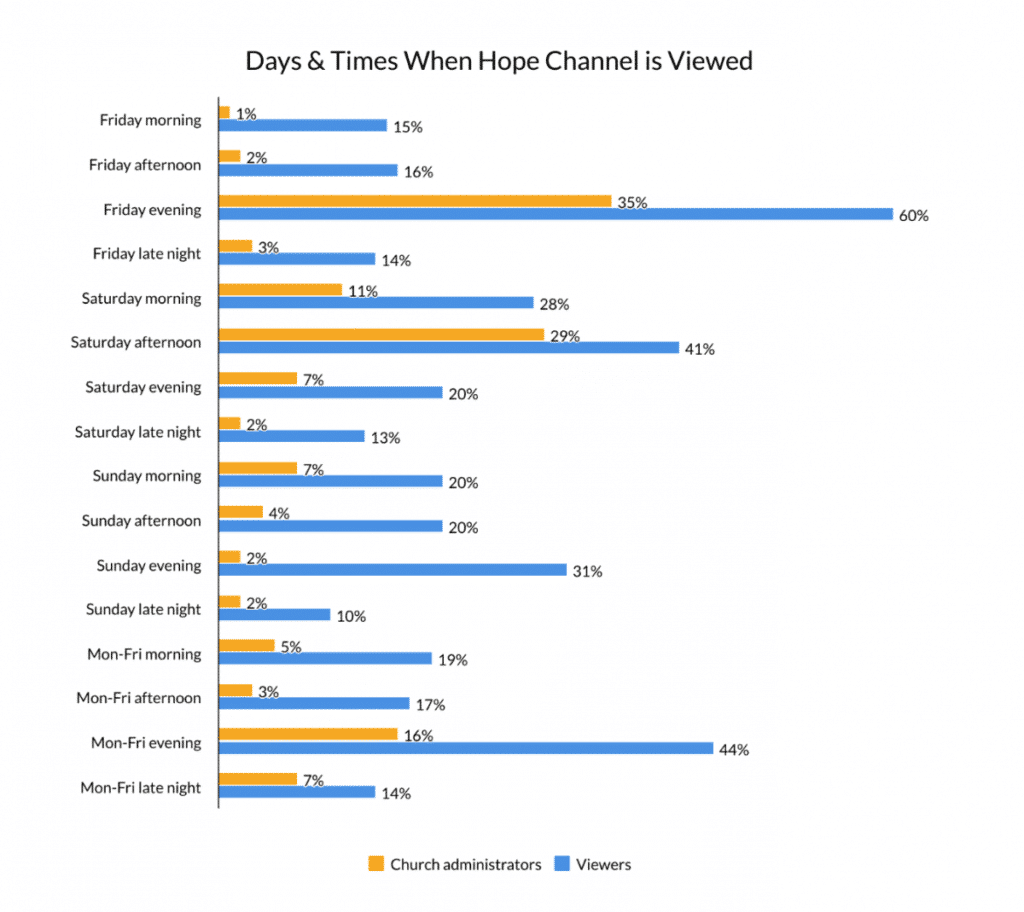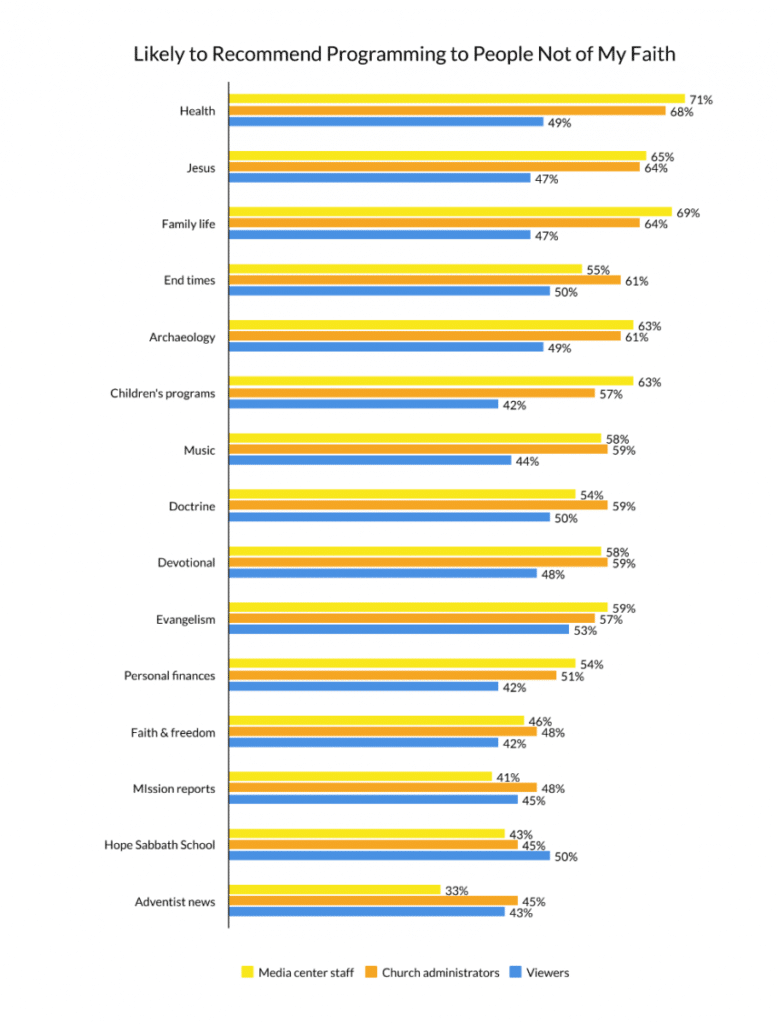Hide it under a bushel – NO! I’m gonna let it shine.
Hide it under a bushel – NO! I’m gonna let it shine.
Let it shine, let it shine, let it shine.
While this is an old song, its message still rings true: if you have a candle meant to light up a room, you are not going to cover it up with a basket. You will let the light shine, filling the room with a warm glow. The same is true when you have good news; it is hard to keep it to yourself!
The Hope Channel is a tool designed by the Adventist Church to share the good news of the gospel. A 2014 study conducted by Paul Richardson, Petr Činčala, and Monte Sahlin with the Center for Creative Ministry, on behalf of the General Conference Office of Archives, Statistics, and Research, surveyed Hope Channel viewers around the world with a total of 18,307 Hope Channel viewer responses. This evaluation study discovered some interesting trends among viewers.
Popular Viewing Times
This study determined that, overall, evening was the most popular time for viewers to tune into Hope Channel programming. It is good news that, at the end of the day, people chose to view Hope Channel among other competitive channels. Friday evening programming was the evening with highest viewing for both church administrators (35%) and viewers in general (60%), which points to the fact that the viewing audience at that time was predominately Adventist. Sabbath afternoon (41%) and evening (38%) are also prime times for viewers in general to tune into the Hope Channel. These findings provided important hints for the Hope Channel producers for creating relevant schedules at the right time for viewers in general.

Most Popular Programming
When it came to the type of Hope Channel programming that was most frequently watched, the study revealed that shows focused on doctrine (65% viewers in general; 65% church administrators) and evangelism (69% of viewers in general; 63% of church administrators) were the most appealing. However, much of the programming appeared to be watched at approximately the same level. Children’s programming, as well as family life programming, was less popular, but wanted to be increased especially by families with children. Programming on faith and freedom, as well as finances, were also less popular.

Recommended Programming for Fellow Adventists
Do viewers’ personal watching preferences align with their programming recommendations to fellow church members? Viewers, themselves, were most likely to recommend programming on evangelism (54%), health (51%), and the end times (50%), which they, obviously, found very useful and relevant. Interestingly, pastors seemed more likely to recommend Hope Channel programming than viewers in general. Programs most often recommended by pastors were focused on the topics of health (66%), Jesus (66%), doctrine (64%), and devotionals (64%). Media Center staff were, by far, the most likely to recommend Hope Channel programming to church members, with children’s programming (85%) being their highest area of recommendation. The results showed that these groups had different priorities and preferences, and thus, different recommendations for church members. In addition, the Media Center staff seemed eager to introduce programs to Adventist viewers and families that they had developed with a feeling that not all programs were very well known among their viewers. This may also point to a lack and need for appropriate advertising about Hope Channel programming among church members.

Recommended Programming for Non-Adventists
When it came to recommending programming to people outside the Adventist faith, viewers in general were most likely to recommend programs focused on the end times (50%), doctrine (50%), and the Hope Channel’s Sabbath School program. Again, pastors were more likely to recommend Hope Channel programming than were viewers in general, with health (68%), Jesus (64%), and family life (64%) being their most highly recommended topics. Media Center staff was most likely to recommend programming on health (71%), family life (69%), Jesus (65%), and children’s programming (65%). This shows that viewers, by and large, were more interested in introducing the Church’s teachings and doctrines to their non-Adventists friends, while church leaders and Media Center staff aimed at Jesus-centered and felt-needs programming as being the most relevant for such audiences at the initial stage of their acquaintance with Hope Channel. It seems they were more ready to follow Christ’s method of reaching people than viewers were.

Thus, the evaluation study showed that at that time, Hope Channel had a predominantly Adventist audience that viewed its programming mostly in the evenings with Friday evening chosen most often. They loved church-related programming and would most likely recommend a similar type of programming to their church and unchurched friends. Church leaders and Media staff were more concerned than viewers in general about bringing Jesus into the lives of their friends. They, (especially the Media Center staff) would most likely invite their non-Adventist friends to watch Hope Channel programming focused on the current needs of modern people such as health, family issues, and children’s programs. Given the results of this study, we can ask how Hope Channel can make a greater impact on those both within and outside the Adventist Church. What role can each member play in making it more known in our communities?
- Word of mouth will always be an effective way of sharing the good news. If there is a Hope Channel program you enjoy watching, be sure to tell someone about it.
- Pastors are in a position to share the good news in a corporate setting, reaching a much larger audience. Making recommendations to your congregation from the pulpit is a good way to share them with many people at one time. Do not forget to mention the children’s and family programming, as this is an under-utilized area of viewership!
- While many churches do not have a Media Center, those that do can use the center to promote the Hope Channel and its programming.
According to Hope Channel, the trend currently indicates that the majority still prefers Friday evening and Sabbath morning as the most popular viewing times, and the most popular program is almost always the Sabbath School lesson.
What is your favorite Hope Channel program? Would you like to give your feedback ? Or if you have non-Adventist friends watching Hope Channel, what programs do they like? We and the Hope Channel team would love to hear from you; tell us about it. And do not forget to tell a friend, too. Do not let this good news pass by without sharing it!
This research was carried out as part of an evaluation of Hope Channel and the full report remains confidential.
Creado en colaboración con el Instituto del Ministerio de la Iglesia (Institute of Church Ministry).
Published by ASTR

